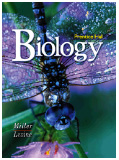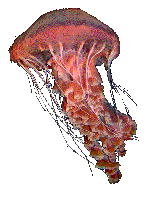BIOLOGY
by Miller & Levine
[complete Table of Contents]

|
Use the pull-down menu to jump to any of the Book's 40 Chapters: |
 Additional
Resources:
Additional
Resources:
![]() Chapter 26
Chapter 26 ![]()
Sponges and Cnidarians
In this chapter, you will read about the general characteristics of animals and the structure and function of two of the simplest animal phyla—sponges and cnidarians. You will also learn about the life cycle and major types of cnidarians. The links below lead to additional resources to help you with this chapter. These include Hot Links to Web sites related to the topics in this chapter, the Take It to the Net activities referred to in your textbook, a Self-Test you can use to test your knowledge of this chapter, and Teaching Links that instructors may find useful for their students.
| Hot Links | Chapter Self-Test |
| Take it to the Net | Teaching Links |
![]()
Section 26-1: Introduction to the Animal Kingdom
![]() An animal is a
multicellular, eukaryotic heterotroph whose cells lack cell walls.
An animal is a
multicellular, eukaryotic heterotroph whose cells lack cell walls.
![]() Animals are specialized
to carry out the following essential functions: feeding, respiration,
circulation, excretion, response, movement, and reproduction.
Animals are specialized
to carry out the following essential functions: feeding, respiration,
circulation, excretion, response, movement, and reproduction.
![]() In general, complex
animals tend to have high levels of cell specialization and internal organization,
bilateral body symmetry, cephalization, and a body.
In general, complex
animals tend to have high levels of cell specialization and internal organization,
bilateral body symmetry, cephalization, and a body.
Section 26-2: Sponges
 Sponges are classified as animals because
they are multicellular, heterotrophic, have no cell walls, and contain
a few specialized cells.
Sponges are classified as animals because
they are multicellular, heterotrophic, have no cell walls, and contain
a few specialized cells.
 The movement of water through a sponge
provides a simple mechanism for feeding, respiration, circulation, and
excretion.
The movement of water through a sponge
provides a simple mechanism for feeding, respiration, circulation, and
excretion.
Section 26-3: Cnidarians
 Cnidarians are soft-bodied, carnivorous
animals that have stinging tentacles arranged in circles around their
mouth. They are the simplest animals to have body symmetry and specialized
tissues.
Cnidarians are soft-bodied, carnivorous
animals that have stinging tentacles arranged in circles around their
mouth. They are the simplest animals to have body symmetry and specialized
tissues.
 Cnidarians typically have a life cycle
that includes two different-looking stages, a polyp and a medusa.
Cnidarians typically have a life cycle
that includes two different-looking stages, a polyp and a medusa.
 Cnidarians include jellyfishes, hydras
and their relatives, sea anemones, and corals.
Cnidarians include jellyfishes, hydras
and their relatives, sea anemones, and corals.